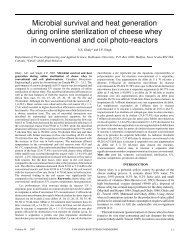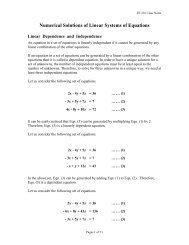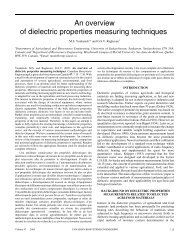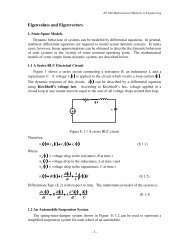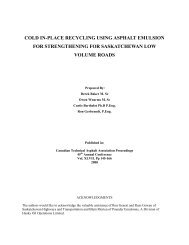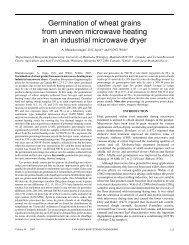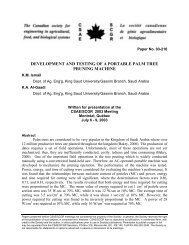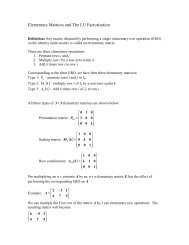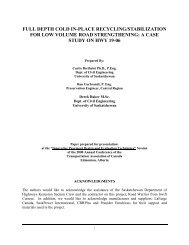Xilinx - Design Reuse Methodology for ASIC and FPGA Designers.pdf
Xilinx - Design Reuse Methodology for ASIC and FPGA Designers.pdf
Xilinx - Design Reuse Methodology for ASIC and FPGA Designers.pdf
Create successful ePaper yourself
Turn your PDF publications into a flip-book with our unique Google optimized e-Paper software.
6The quality of IP <strong>for</strong> <strong>ASIC</strong>s depends on whether it has been verified using a specific <strong>ASIC</strong>technology library. The ultimate proof of the quality of the IP is that it has been implemented in adesired <strong>ASIC</strong> technology. Implementing an IP or reuse module in more than one <strong>ASIC</strong>technology is costly. However implementing IP or reusable modules in a variety of <strong>FPGA</strong>devices is not.Faster Testing <strong>and</strong> Manufacturing - <strong>ASIC</strong>s require rigorous verification strategies to avoidmultiple cycles through manufacturing. The manufacturing <strong>and</strong> test strategies must be welldefined during the specification phase. Often different strategies must be used depending on thetype of block. Memory blocks often use BIST or some <strong>for</strong>m of direct memory access to detect<strong>and</strong> troubleshoot data retention problems. Other logic such as microprocessors requires customtest structures <strong>for</strong> full or partial scan or logic BIST.<strong>FPGA</strong> designs, on the other h<strong>and</strong>, are implemented on reprogrammable devices that are 100%tested by the manufacture, be<strong>for</strong>e reaching the designer. In fact, <strong>FPGA</strong>s can be used to create testprograms downloadable into other non-reprogrammable devices on the board. There is no nonrecurringengineering (NRE) cost, no sign-off, <strong>and</strong> no delay while waiting <strong>for</strong> prototypes to bemanufactured. The designer controls the entire design cycle, thereby shrinking the design cycle aswell as the time to prototype. This allows essential steps such as firmware designing to occur at astage late in the design flow but actually earlier in the actual design time.Verification – <strong>ASIC</strong> technology requires strict verification be<strong>for</strong>e manufacturing. In largecomplex system level designs many more unexpected situations can occur. SoRC designers havea much more flexible in-system verification strategy. The designers can mix testbenchverification strategies with in-circuit testing, thereby offering faster verification without the costof accelerated simulators. Surveys of design engineers have found that the area of test vectorgeneration <strong>and</strong> vector-based verification is the least favorite part of system design process.Hardware <strong>and</strong> Software Co-<strong>Design</strong>ing - Early versions of the systems prototype can be used tofacilitate software <strong>and</strong> hardware co-design.1.3 A Common <strong>Design</strong> <strong>Reuse</strong> StrategyThe dramatic improvement in <strong>FPGA</strong> architecture, pricing <strong>and</strong> design tools in the past few yearshas made it possible <strong>for</strong> <strong>ASIC</strong> <strong>and</strong> <strong>FPGA</strong> designers to share a common design methodology.<strong>Design</strong>s requiring per<strong>for</strong>mance in the 30 – 50 MHz range are usually implemented using a RTLsynthesis design methodology making a common <strong>ASIC</strong> <strong>and</strong> <strong>FPGA</strong> design reuse strategy possible.However, designs requiring higher per<strong>for</strong>mance, will usually require additional techniques uniqueto the <strong>FPGA</strong> environment. A common design <strong>and</strong> design reuse strategy provides the flexibility tochoose the best method to implement a system design without the overhead of retraining thedesign teams. In addition, one can take advantage of the design rules <strong>and</strong> guidelines found inreuse methodology manuals such as the <strong>Reuse</strong> <strong>Design</strong> <strong>Methodology</strong> Manual from Synopsys <strong>and</strong>Mentor or the web-based <strong>Reuse</strong> <strong>Methodology</strong> Field Guide from Qualis.There are many challenges facing Soc/SoRC designers such as time-to-market pressures, qualityof results, increasing chip complexity, varying levels of expertise, multi-site teams <strong>and</strong>management <strong>and</strong> implementation of a reuse strategy. <strong>FPGA</strong> designers are faced with theadditional challenges of architectures with varying system features, meeting difficult per<strong>for</strong>mancegoals <strong>and</strong> different implementation strategies. This paper addresses these unique challenges byshowing how the guidelines found in the <strong>Reuse</strong> <strong>Design</strong> <strong>Methodology</strong> Manual can be applied



